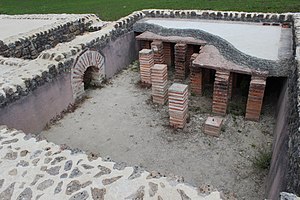
Back هيبوكاوستوم Arabic Хипокауст Bulgarian Hipocaust Catalan Hypokaust Czech Hypokaustum German Υπόκαυστο Greek Hipokaŭsto Esperanto Hipocausto Spanish Hüpokaust Estonian Hipokausto Basque

A hypocaust (Latin: hypocaustum) is a system of central heating in a building that produces and circulates hot air below the floor of a room, and may also warm the walls with a series of pipes through which the hot air passes. This air can warm the upper floors as well.[1] The word derives from Ancient Greek hupó 'under' and kaustós 'burnt' (compare caustic). The earliest reference to such a system suggests that the Temple of Ephesus in 350 BC was heated in this manner,[2] although Vitruvius attributes its invention to Sergius Orata in c. 80 BC.[3] Its invention improved the hygiene and living conditions of citizens, and was a forerunner of modern central heating.
- ^ Tomlinson, Charles (1850-01-01). A rudimentary treatise on warming and ventilation: being a concise exposition of the general principles of the art of warming and ventilating domestic and public buildings, mines, lighthouses, ships, etc. J. Weale. pp. 53.
hypocaust.
- ^ Mitchell, Patrick (2008-03-01). Central Heating, Installation, Maintenance and Repair. WritersPrintShop. p. 3. ISBN 9781904623625.
- ^ Forbes (1966-01-01). Studies in Ancient Technology. BRILL. pp. 54–55. ISBN 9004006265.